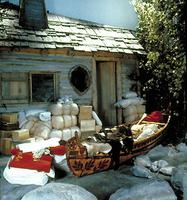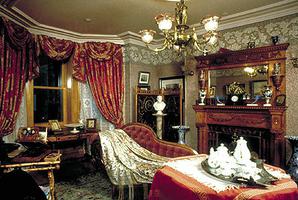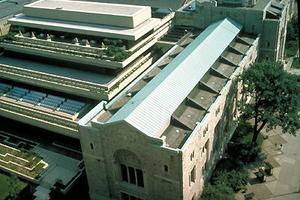Art Galleries and Museums
Art galleries and museums are institutions that collect, preserve, study and present permanent collections of heritage objects to the public. According to the Canadian Museums Association, there are currently over 2300 museums and related institutions in Canada. Although authentic documentation of the early history of Canadian museums is meagre, it is known that 18th-century religious institutions in Québec and the Maritimes had natural history collections that were used by the priests-educators. These same Church schools accumulated religious relics, curiosities and votive paintings, which marked the beginnings of immigrant art in Canada. What was later Université Laval had mineralogical collections as early as the 1790s, followed soon after by other universities, but museums as formally organized institutions were unknown.
In the early 1800s Mechanics' Institutes in the Maritimes accumulated collections for teaching purposes; in addition, models that illustrated physical phenomena and the means by which machinery functioned were constructed. Also during this time, miscellaneous collections were garnered from exhibitions, teaching collections or personal "cabinets of curiosities" and assembled in libraries or government buildings for temporary show or special events.
The first museum in Canada seems to have been opened by Thomas Barnett, who advertised his personal museum of local and foreign specimens at Niagara Falls in 1831. Soon after, a less commercial museum opened at Niagara-on-the-Lake, and Dr Abraham Gesner founded his museum at Saint John, NB, in 1842. Museums were formally established at Université Laval and the Canadian Institute in Toronto in 1852, followed by one at McGill University in 1856. Nova Scotia opened the first provincial museum in 1868 in Halifax, based on collections assembled in a local mechanics' institute, and BC and Ontario sponsored formal museums in 1886 and 1887, respectively.
Museum Movement of the 19th Century
It was not until after Confederation in 1867, however, that the museum movement swept across Canada, becoming a hallmark of the late 19th century. An outline of the early history of the National Museum of Canada illustrates the blend of private initiative, government support and opportune circumstances that marked the development of museums. In 1842 William Logan had become geologist of the Province of Canada, and by 1845 he had amassed and catalogued a large comparative collection of specimens. After the collection was exhibited in London in 1851, Logan and the government were encouraged to found a permanent geological museum.
By mid-century, developers and the government recognized the value of national collections in encouraging exploration and resource development. In 1853 Logan wrote a report to Parliament that eventually generated a grant of $28 000 for the maintenance of the collection and for publications. In 1881 Logan's museum was moved to Ottawa to be a part of the research collection and museum of the Geological Survey of Canada.
Modest Expansions
A long period of underfunding and lack of organization followed, though in 1911 the museum moved into the new Victoria Memorial Museum Building. In 1927 the museum was formally recognized as the National Museum of Canada, which eventually evolved into the Canadian Museum of Nature. The National Gallery of Canada was established in 1880 (see also National Museums of Canada).
It was in the first half of the 20th century that small community museums and the remaining provincial museums were founded (see Art Gallery of Ontario; Glenbow Museum; Royal Ontario Museum). The earliest museums were situated in eastern Canada, but as immigrant settlers moved to the West, pride in their varied ethnic origins gave birth to many collections that eventually became community or regional museums. The growth of museums was slow, and 2 major reports, the Miers-Markham Report of 1932 and the Massey Report of 1951, showed little development over a 20-year period.
Post-Centennial Initiatives
Centennial Year in 1967 and several provincial and metropolitan birthdays in the 1960s gave a marked impetus to museum development. Provinces and communities alike chose to commemorate their heritage by starting new museums or modernizing old ones. A landmark event was Secretary of State Gérard Pelletier's announcement in 1972 of the National Museums Policy, which was based on the goals of "democratization and decentralization." From this policy came the creation of such key programs as the Museums Assistance Program, the National Inventory Program (now known as the Canadian Heritage Information Network), and the Canadian Conservation Institute. The Cultural Property Export and Import Act, which helps ensure that Canada's heritage remains in this country, followed soon after. These initiatives helped museums become more professional, expand their collections and exhibitions, and reach new audiences with new programs. Within the next decade, almost all the provinces responded with their own programs for museums. The federal government's commitment to the museum policy was reconfirmed in 1990.
Funding and Operation
In 1997-98 museums received just over 60% of their budgets from government sources. However, government support has not kept up with operating expenditures. The museum community has been particularly critical of the federal Museums Assistance Program, which was launched in the early 1970s with a budget of $8 million and almost 30 years later (in 2000-01) had $9.4 million to contribute to over 200 museums across the country. MAP's current focus is on assisting travelling exhibitions designed to deepen Canadian understanding of the Canadian experience, helping small and medium-sized museums with the costs of borrowing exhibits from other regions, and supporting the organizational development of aboriginal museums.
A number of museums are owned and operated by governments - federal, provincial, territorial or municipal - but most museums are run by private non-profit societies. Whatever their provenance, museums seek funding from all 3 levels of government and the private sector, in addition to generating their own revenues through admission fees, gift shops, and other sales and services.
Current Trends
Three trends are affecting art galleries and museums at the turn of the century. First, they are working intensively to diversify their revenue base and expand audiences. Since the mid-1990s, with public sector funding lagging behind expenditures, museums have sought to become more relevant to their visitors, attract more corporate sponsors and donors, broaden their revenue base, and expand business ventures such as gift shops. Education and outreach efforts have achieved new importance, and an increased emphasis has been placed on touring exhibitions and on creating compelling experiences for museum visitors through interactive and multimedia activities. Collaborations with local tourism authorities and tourist destinations like convention centres, hotels and restaurants are more common. Among the larger institutions, blockbuster exhibitions have become popular crowd-pleasers. While these trends have raised concerns about the "Disneyfication" of the museum sector, given the powerful competition for audiences and resources, they are not likely to be reversed.
A second major trend is the increasing awareness among Canadian museums of the value and importance of Aboriginal art and artifacts and of their responsibilities as stewards and custodians of Canada's physical legacy, some of which belongs to the Aboriginal peoples. In 1991 a major task force on museums and first peoples jointly supported by the Canadian Museums Association and the Assembly of First Nations provided great impetus to collaborations between Aboriginal communities and heritage institutions. The task force established an ethical framework and guidelines for the use of Aboriginal objects and representation of Aboriginal culture that have been very influential within Canada and abroad.
Similarly, museums have begun to recognize and adapt their operations to the growing cultural diversity of the Canadian population. The subject of cultural diversity and museums has been on the public agenda since at least 1994, when the Canadian Museums Association held a symposium on the topic. Increasingly, museums are involving cultural communities and neighbourhoods in the early stages of developing exhibitions that concern them and setting up advisory committees of citizens from diverse groups for collection and exhibition planning.
Finally, both within their own operations, as contexts for their exhibitions, and as means of sharing the rich resources in their collections, museums are exploring the possibilities opened up by digital technology. Many are digitizing works in their collections, and the Canadian Heritage Information Network is developing a "virtual museum" on the Internet to help museums develop multimedia presentations of themes based on their collections and exhibitions.
See arts, heritage and cultural industries funding; museum policy.

 Share on Facebook
Share on Facebook Share on X
Share on X Share by Email
Share by Email Share on Google Classroom
Share on Google Classroom








